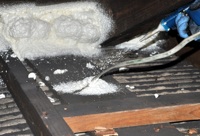Exclusive: Fomo seals the leaks in a 100-year-old home
Spray foam insulation eliminates drafts and reduces air infiltration by more than 20 percent in a 1912 colonial home.
Cuyahoga Falls, Ohio, a suburb of Cleveland, is marked by quaint neighborhoods and historical homes dating back to the early 1900s. While these turn-of-the-century homes offer charming character and impressive architectural lines, things like insulation, plumbing, windows and doors often incorporate age-old materials that contribute to higher heating and air-conditioning bills.
To showcase the impact spray polyurethane foam (SPF) could make in stopping air infiltration in these area homes, Fomo Products, Inc., one of the largest global manufacturers of one- and two-component low pressure SPF sealants, adhesives and insulation, partnered with homeowners of a 1912 colonial home for an insulation retrofit. Existing insulation at the 1,475-square-foot home consisted of corrugated cardboard and fiberglass batts in the attic, which the homeowners felt might not be sufficiently stopping air infiltration.
Testing and Planning
Before embarking on an insulation recommendation, certified Building Performance Institute (BPI) analysts from Fomo conducted a blower door test on the home. The industry-standard test involves mounting a powerful fan into the frame of an exterior door. Once the fan is turned on, it pulls all of the air out of the house, lowering the pressure inside. The outside air then flows into the house through all unsealed cracks and openings to represent the home's true air infiltration. In this test, a smoke pencil, an industry tool professional installers use to identify drafts, and an infrared camera were used to detect air leaks and locate specific points of air infiltration.
These tests revealed that the hourly air exchanges were at 13.7 ACH50, more than double the recommended minimum ventilation requirement for a home of this size. Sizeable air leaks were coming through the home's framing, attic, concrete foundation and decking. Analysts determined using SPF, in addition to traditional insulation, would allow for optimal air sealing in these areas and maintain an economical R-value.
 |
 |
 |
 |
Insulation Application
To improve the home's air exchanges and stop air infiltration, contractors used Fomo's low-pressure Handi-Foam Spray Polyurethane Foam on the attic floor, around rim joists and under a bay window. This included a critical seal of junction box and wire penetrations in the attic, followed by a 1-inch coating of Handi-Foam SPF on the attic floor to further seal and insulate. Contractors also added R-42 loose cellulose over the top of the SPF in the attic to cost effectively boost the R-value. In addition, two inches of Handi-Foam was applied to the rim joists and below the bay window.
"Using spray polyurethane foam products offered this home a level of air sealing that could not have been achieved using traditional fiberglass insulation alone," says Sara Jonas, senior manager-marketing, Fomo Products, Inc. "SPF more adequately seals around rim joists and tight spaces to protect against air infiltration. Traditional fiberglass can insulate but not seal these areas, meaning air will still come through."
Real-World Results
Following the SPF install, new blower door tests revealed a 22 percent reduction in hourly air exchanges with a much-improved hourly air exchange rate of 10.6 ACH50. Since the insulation, the homeowners have noticed a drastic reduction in drafts and an elimination of cold spots on the floor, which has increased their comfort dramatically.
About Fomo
Fomo Products, Inc. USA was founded in 1975 and is a member of the FLM Group of Companies. The FLM Group is one of the world's largest manufacturers of low pressure one- and two-component polyurethane foam sealants, adhesives and spray foam in pressurized, disposable and refillable packaging. Fomo Products, Inc. management system carries an ISO 9001 management system registration. Other products manufactured by Fomo Products, Inc., include Handi-Foam Sealants and Spray Foams, Handi-Seal Window and Door Sealants and Handi-Stick Adhesives.
For information about Handi-Foam Spray Polyurethane Foam or any Fomo product contact: Fomo Products, Inc., Customer Care Department, 2775 Barber Road, PO Box 1078, Norton, Ohio, 44203. Phone: +1 330.753.4585. Outside Ohio: +1 800.321.5585. Fax: +1 330.753.9566. Web site: www.fomo.com.
















